The NFT Market – Why talk about it?
To put it simply, nonfungible tokens (NFTs), are assets one can buy on the blockchain. In the arts administration space, the debate about the role of NFTs in our scope is alive and well. On one hand, there is the argument that NFTs are a new frontier for entrepreneurial artists because they allow for a decentralized avenue for art marketing and sales. The blockchain, in theory, is an extremely well structured platform for artists’ sales because it is managed by smart contracts, which allow artists, if savvy enough, to receive royalties from all future sales. Smart contracts are simply lines of code that program currency and legal transfers in relation to each NFT sale. They elegantly ensure integrity for artists’ rewards by removing any middlemen between them and what they deserve in exchange for their work.
It is shockingly easy to “mint” an NFT, and by Web3 dictionary standards, minting means converting a digital asset, like a unique drawing, into a marketable item on the blockchain. This is another reason why we are hearing about NFTs in the arts sector. Popular NFT marketplaces like OpenSea use what’s called a “lazy minting” process that lets artists drop their digital goods off for purchase on their platform at no cost. OpenSea then puts the cost of their service on the NFT buyer, charging them an additional 2.5% of the NFT’s market price. This is similar to what a small business may do to their customers using credit cards when they charge an extra processing fee.

As seen in the image above, NFT trading volume on OpenSea rose from the winter of 2021 to the beginning of 2022, peaked in January of 2022, and began to decline into the rest of the year, while the public’s interest in NFTs followed a similar trajectory. If the NFT market is structured to benefit artists, one could argue that this is a prime time for more artists to improve their NFT-selling strategies and increase this volume. However, there are two sides to every story, and the NFT market is not as easy to navigate in practice as in theory. There are many complexities involved in building a successful NFT brand. For example, setting up a strong smart contract involves collaboration between an artist, a development team, and ideally a lawyer. Lawyers can be crucial in advising smart contract line items for artists like the ability to sell their NFTs off of the blockchain and receive rewards in perpetuity for future sales. Essentially, digital artists have a lot to learn before entering the NFT market, and it will take a plethora of resources for them to create sustainable and smart personas on the blockchain.
The promise of a decentralized marketplace and autonomy over commercializing art has drawn over 10,000 collections of NFTs to OpenSea. This has created a massive NFT supply, yet not all of the artists who lazy mint on the platform are well equipped with the skills to stand out in the market. This brings up a couple of questions worth exploring. What types of artists can and do succeed in the NFT market in 2022? What type of person is buying NFTs in the current market, and why? As it turns out, the average popular NFT consumer is paying a high price for this digital asset, and they are buying because of factors beyond the NFT’s art itself. A look into OpenSea’s current top 50 most successful NFT art collections will illuminate this.
Successful NFT Collections – OpenSea Captains
To understand what a “successful” NFT collection looks like on OpenSea, we can examine which collections have earned the highest “volume”, or largest sum, of cryptocurrency to date in Ethereum (ETH.) As of the spring of 2022, the statistics for the top 50 NFT collection sales are as follows. This data was scraped from OpenSea’s Developer API, and the below averages are per collection out of the top 50.
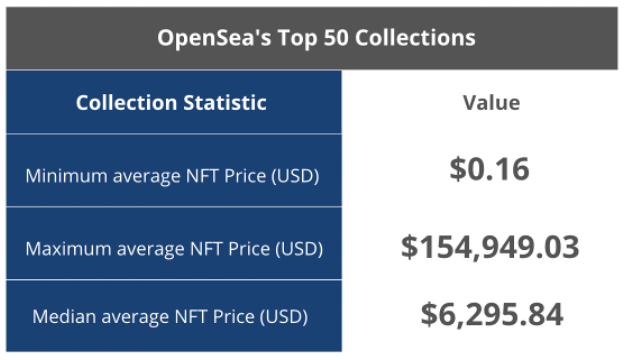
These values show that the range NFT prices in successful OpenSea collections is vast, but that ultimately, popular purchases are concentrated in the multi-thousand-dollar range. Since we have defined successful NFT collections here in terms of their accumulated wealth, we can say that the wealthy portion of the NFT market is making their gains through contributions from individuals who can afford to spend large sums on each individual NFT. One of the most expensive NFTs ever sold was Everydays: The First 5000 Days by the artist Beeple at 69.3 million dollars. So, there are collectors in the market who are so interested that they will even spend millions. From looking further into OpenSea’s popular collections, it is apparent that they have anywhere from 52 to 212,072 individual owners contributing to their sales. This range shares that there are hundreds of thousands of individuals who want a piece of the NFT market as well. For artists’ sake, arts managers should understand this type of collector, who they are, and why they buy.
As one high-value NFT owner stated, his NFT is a status-symbol and one of his most prized possessions. Some large companies like Adidas and Taco Bell have started casually experimenting with NFT purchases to convert them to physical artwork and Web3 real-estate as well. Another reason that big companies and individuals alike invest in NFTs is that these digital items come with extra benefits beyond the ownership of art on the blockchain. In fact, it’s debatable as to whether artistic value is even of consideration for buyers. A dive into NFT benefits and gamification can explain this further.
NFT Benefit Models to Watch
Play-To-Earn
Video-gamers can now sell NFTs in virtual universes and make actual money, hence there is an incentive to play games with blockchain components to make a tangible profit. Gone are the days of art for art appreciation’s sake with NFTs when this new “play-to-earn” gaming model is readily available. However, there are some positive outcomes of the advent of the play-to-earn model. For example, trading NFTs is a major component of playing games on the blockchain. This means that smart contracts behind the scenes in the games give participants partial ownership of the game, and in some rare cases, a say in its future development.
Axie Infinity is widely known as one of the most popular play-to-earn games on the market, and it refers to itself as a “player-owned economy” because it is taking revolutionary steps to give control over its future development to its players. The game has a public, multi-year development roadmap for how they plan to incorporate players’ interests into game development. Their desired communal structure for player power is described below. From sales within the game’s NFT marketplace, players can earn “AXS” currency, of which a portion gets added to the game’s “Community Treasury.” The amount of AXS a player accumulates in the Treasury dictates their stake in future development decisions and ultimately provides them with additional rewards. In theory, this structure creates a democratic and meritocratic culture within the Axie Infinity Game Universe that entices users to play by giving them the chance at voting power over its future.

The Avatar Movement
Imagine getting to start from scratch again when creating your digital identity and online presence. It has been decades now since we have been able to do this, and the thought sounds exciting and foreign given the seemed permanence of everything we’ve posted online. However, the Avatar Movement uses “algorithmically generated” NFTs to give buyers a chance at a unique identity in the digital world’s next universe: the metaverse.
The digital artist of a specific avatar collection can create a list of possible features for persona NFTs, give them empowering descriptions, and then combine them to create unique characters that give buyers the chance to adopt a new online identity. Sotheby’s Auction House hosted an NFT avatar collection auction called Queens+Kings in 2021, and some of the avatars from this event are now on OpenSea where collectors can re-mint and rearrange them to create new identities at each sale. Beyond providing creative metaverse identities, NFT avatars are also appealing assets because they can generate passive income for their human owners in the metaverse. They can even have their own agents like some celebrity avatars have had for years now. If the metaverse grows in popularity, the Avatar Movement should grow in tandem as the public joins the bandwagon in making new identities for themselves in the digital frontier.
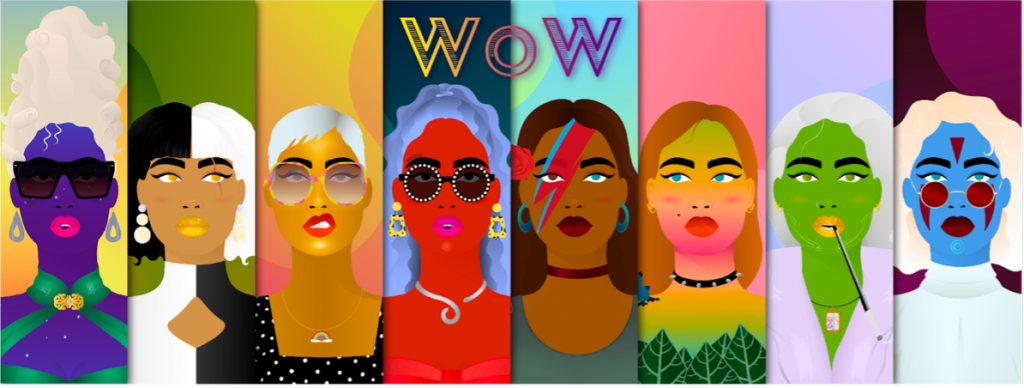
Exclusivity
Another draw of buying NFTs in the current market is that they typically come with an invitation into an exclusive community. For example, Sotheby’s first NFT auction sold avatars that mimicked players from the Liverpool FC team, and in return for their purchase gave collectors “access to a members-only LFC Discord community chat channel, virtual hang-outs, competitions, guest appearances, updates from the LFC Foundation, and LFC retail discounts.” Luxury brands are also taking advantage of NFT collections as alternative revenue streams. Louis Vuitton gamified their company’s history by creating an environment where shoppers can learn about the brand’s origins while receiving luxury NFT drops as random rewards. According to crypto.news, “blockchain-based gaming will completely eclipse the entire gaming industry.” It seems as well that block-chain-based NFT sales and gamification will disrupt industries from football to fashion by creating new exclusive benefits for fans.
Miscellaneous
Time-Sensitive and Outcome-Based NFTs
Time-sensitive and outcome-based NFTs – Artists can program NFT purchases to host an element of surprise by revealing their art based on a time or event like the result of the 2020 election. Coachella 2022 decided to go with a flower theme for their ticket-holder NFTs, and these items were programmed to appear as seeds until the festival began and they grew into different types of flowers, each denoting a unique exclusive deal.
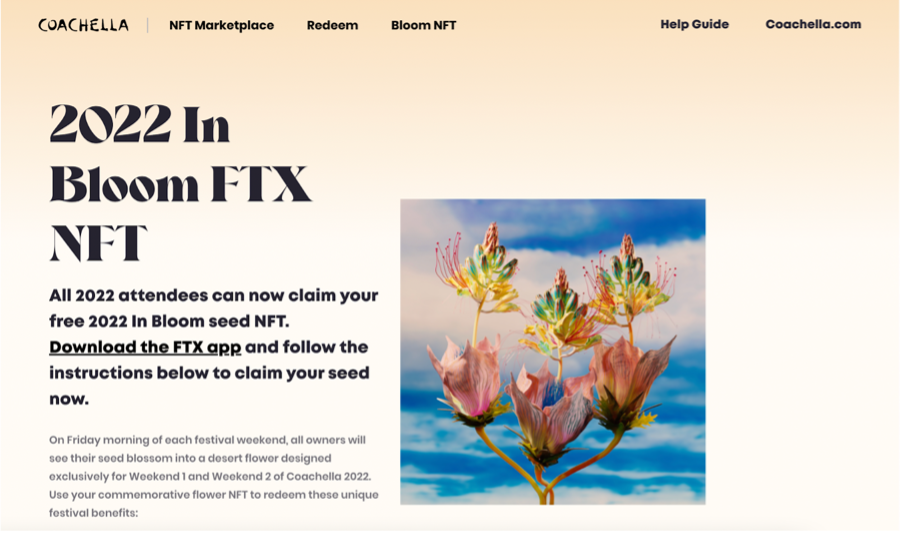
Raffles/Other Surprise Elements
The BitCoin Angel project did well in the NFT market partially because it sold smaller pieces from artist Trevor Jones for a chance at 1/1 ownership of one of his original works. This project turned Jones from a struggling artist into a multimillionaire in a single day.
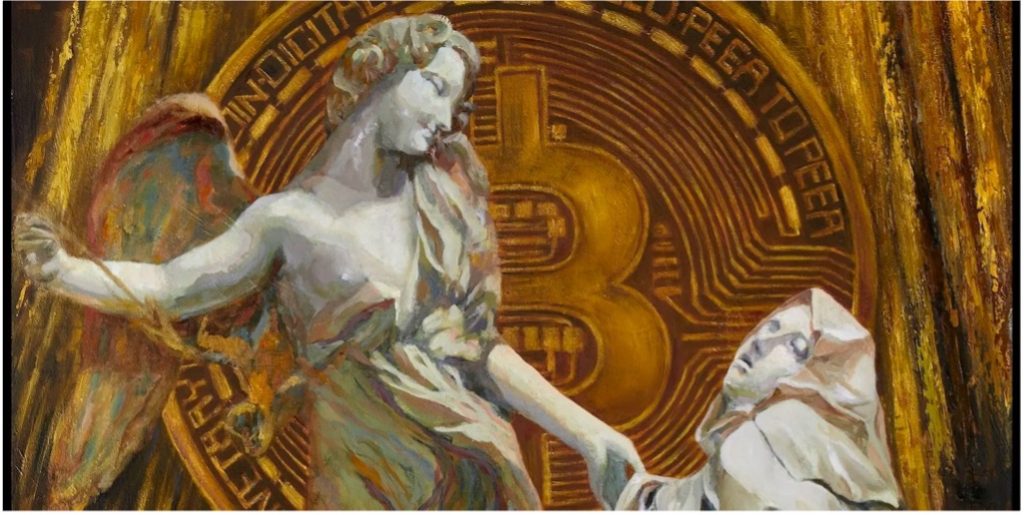
Takeaways for the Arts Community
One beautiful aspect of the arts is that they prevail through, and react to, the changing world around them. The NFT market and the metaverse space is the next economic frontier for art to infiltrate and revolutionize, but this market is both promising and elitist. Therefore, it’s worth paying attention to as artists and managers alike. To stay abridged to the market, it will be important that the arts and culture sector monitor its trends.
With the rise in play-to-earn gaming and metaverse developments, now is an apt time for artists and arts managers to research and educate each other on minting, smart contracts, and collection gamification best practices. Before entering the market, it is also vital to research both prominent NFT development teams and legal resources to plan for a value-centric and secure benefit strategy and launch. There have been many copyright issues around NFT sales and confusion over what a buyer can do with their NFT once they purchase it. Each of these issues warrants its own in-depth study, and the examples of successful NFT collections above are only the tip of the iceberg in cases for the NFT market’s potential moving forward. This NFT phenomenon may be about more than just buying and selling digital art, but it is surely a robust and decentralized outlet for artists, nonetheless. The NFT market is a playground, colorful and treacherous, for entrepreneurial artists and innovative arts institutions.
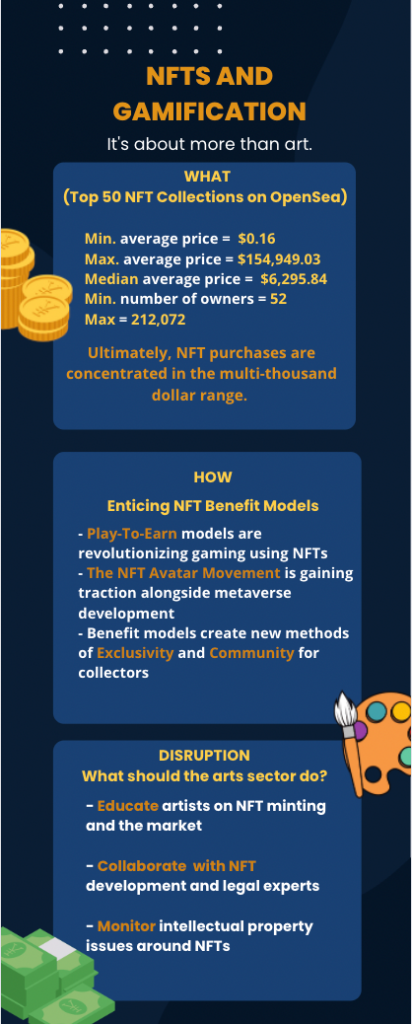
Sources
“70% Of All NFT Collections on OpenSea Don’t Have Any Sales, Says New Study by Meta Generation.” Accessed May 2, 2022. https://southeast.newschannelnebraska.com/story/46043373/70-of-all-nft-collections-on-opensea-dont-have-any-sales-says-new-study-by-meta-generation.
“A Brief Study of Decentralized Autonomous Organization (DAO) in Blockchain -,” June 6, 2021. https://www.blockchain-council.org/blockchain/a-brief-study-of-decentralized-autonomous-organization-dao-in-blockchain/.
AlexWGomezz. “NFT Royalties: What Are They and How Do They Work?” Cyber Scrilla. Accessed May 2, 2022. https://cyberscrilla.com/nft-royalties-what-are-they-and-how-do-they-work/.
AMT Lab @ CMU. “NFTs Legal Considerations and Implications.” Accessed May 3, 2022. https://amt-lab.org/blog/2021/9/nft-considerations-and-implications.
“Axie Infinity Shards – $AXS.” Accessed May 3, 2022. https://whitepaper.axieinfinity.com/.
“Best NFT Marketplaces for Music | AirNFTs.” Accessed April 6, 2022. https://www.airnfts.com/post/best-nft-marketplaces-for-music.
Canstar. “What Does It Mean to Mint an NFT?” Accessed May 2, 2022. https://www.canstar.com.au/cryptocurrency/mint-nft/.
Chou, Author Yu-kai. “3 Great Gamification Examples in Blockchain and NFTs.” Yu-Kai Chou: Gamification & Behavioral Design (blog), March 15, 2022. https://yukaichou.com/nft/3-great-gamification-examples-in-blockchain-and-nfts/.
“Coachella 2022: Festival Drops Free NFTs That Can Blossom into VIP Perks – Daily News.” Accessed April 6, 2022. https://www.dailynews.com/2022/04/01/coachella-2022-festival-drops-free-nfts-that-can-blossom-into-vip-perks/.
Crypto King. Axie Infinity Is Becoming Decentalized! News Update, 2022. https://www.youtube.com/watch?v=uw7KeB2kQ_o.
DEFIX, DEFIESCROW. “Introduction to NFT Gamification.” The Capital (blog), October 15, 2021. https://medium.com/the-capital/introduction-to-nft-gamification-39d75f5a9384.
Fortune. “You’ll Soon Be Able to Put Your Metaverse Avatar to Work—and Make Actual Money from It.” Accessed May 3, 2022. https://fortune.com/2022/02/07/metaverse-avatar-work-make-money-nft/.
Hayward, Decrypt / Stephen Graves, Daniel Phillips, Andrew. “The 15 Most Expensive NFTs Ever Sold.” Decrypt, February 21, 2022. https://decrypt.co/62898/most-expensive-nfts-ever-sold.
“Know Who’s Buying NFTs to Successfully Sell Your Art | Creative Bloq.” Accessed April 13, 2022. https://www.creativebloq.com/features/know-who-is-buying-nfts.
MAL. “NFT Gamification: 7 Ways Crypto Artists Are Using NFTs to Engage with Collectors | NFT Culture | NFT News | Interviews and More.” NFT Culture (blog), March 23, 2021. https://www.nftculture.com/nft-art/nft-gamification-7-ways-crypto-artists-make-collecting-nfts-fun/.
Music Business Worldwide. “The Gamification of the Music Industry Has Just Begun.,” February 3, 2022. https://www.musicbusinessworldwide.com/the-gamification-of-the-music-industry-has-just-begun/.
Nast, Condé. “Louis Vuitton to Release New NFTs.” Vogue Business, April 14, 2022. https://www.voguebusiness.com/technology/louis-vuitton-to-release-new-nfts.
“NFT Gamification: How Blockchain Is Redefining The Gaming Industry – Crypto.News,” November 22, 2021. https://crypto.news/nft-gamification-blockchain-gaming-industry/.
“NFTs Explained: Why People Spend Millions of Dollars on JPEGs – CNET.” Accessed April 13, 2022. https://www.cnet.com/culture/nfts-explained-why-people-spend-millions-of-dollars-on-jpegs/.
OpenSea. “Bored Ape Yacht Club – Collection.” OpenSea. Accessed April 6, 2022. https://opensea.io/collection/boredapeyachtclub. published, Ian Dean. “10 NFT Trends That Could Change the World in 2022.” Creative Bloq, February 28, 2022. https://www.creativebloq.com/features/nft-trends-2022.
OpenSea Developer Documentation. “Retrieving a Single Collection.” Accessed May 2, 2022. https://docs.opensea.io/reference/api-overview.
Rizzo, Jessica. “The Future of NFTs Lies With the Courts.” Wired. Accessed May 4, 2022. https://www.wired.com/story/nfts-cryptocurrency-law-copyright/.
“Roadmap and Completed Milestones.” Accessed April 20, 2022. https://whitepaper.axieinfinity.com/.
“Sotheby’s Metaverse.” Accessed April 6, 2022. https://metaverse.sothebys.com/lfc/auction.
“Sotheby’s Metaverse.” Accessed April 6, 2022. https://metaverse.sothebys.com/hackatao-queens-and-kings.
TALKSONLAW. How Do NFT Royalties Work? We Ask Two Blockchain Lawyers…, 2021. https://www.youtube.com/watch?v=DEINmfesK7Q.
The Economist. What Are NFTs? | The Economist, 2022. https://www.youtube.com/watch?v=EJzB_Fa27ko.
UMG. “BILLBOARD TO LAUNCH MUSIC NFT PROJECT CHARTSTARS WITH UNIVERSAL MUSIC GROUP ARTISTS FIRST TO DEBUT ON THE DIGITAL COLLECTIBLE MARKETPLACE,” March 2, 2022. https://www.universalmusic.com/billboard-to-launch-music-nft-project-chartstars-with-universal-music-group-artists-first-to-debut-on-the-digital-collectible-marketplace/.
World Economic Forum. “What Do You Actually Own When You Buy an NFT?” Accessed May 4, 2022. https://www.weforum.org/agenda/2022/02/non-fungible-tokens-nfts-and-copyright/.
“Why Big Brands Are Spending Millions On NFTs.” Accessed April 13, 2022. https://www.forbes.com/sites/robertfarrington/2021/12/25/why-big-brands-are-spending-millions-on-nfts/?sh=67e5efad6117.
“Why Gamified NFTs Are So Popular Among Dance Music Artists – CryptoSaurus,” March 28, 2022. https://cryptosaurus.tech/why-gamified-nfts-are-so-popular-among-dance-music-artists/.
Wilser, Jeff. “How ‘World of Women’ Became a Celebrity NFT Phenom,” September 16, 2021. https://www.coindesk.com/business/2021/09/16/how-world-of-women-became-a-celebrity-nft-phenom/.
WIRED. Blockchain Expert Explains One Concept in 5 Levels of Difficulty | WIRED, 2017. https://www.youtube.com/watch?v=hYip_Vuv8J0.